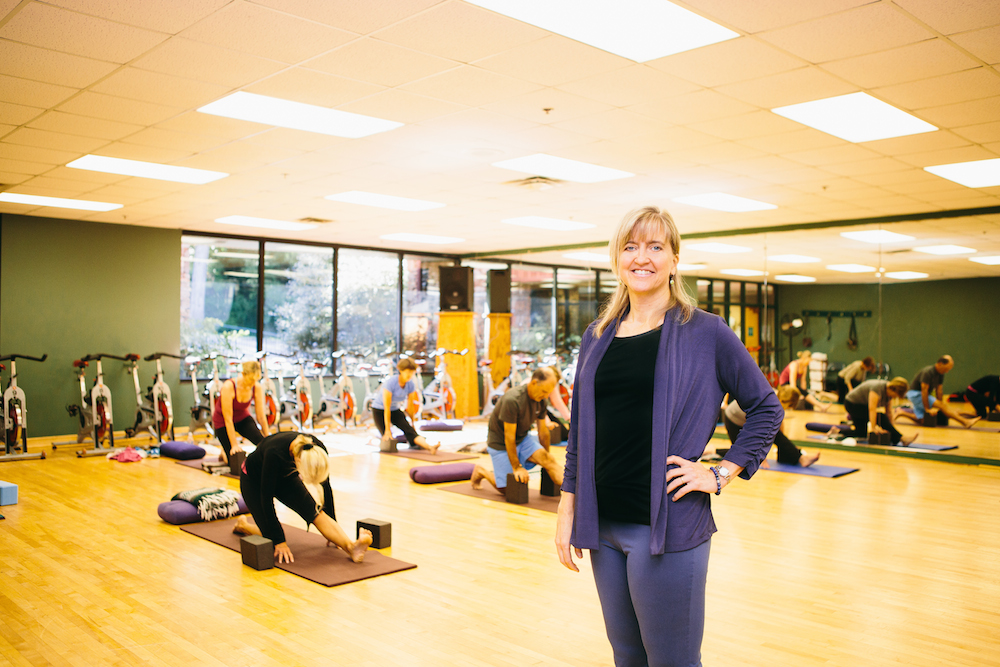Kristine Kaoverii Weber is a big-picture person. So although she’s the creator of Subtle Yoga, she spends less time thinking about yoga studios, complicated poses or the latest yoga pants and more time thinking about the current state of health care. It’s also what has led her to begin teaching behavioral health professionals how to use yoga with their patients.
“I always start out with the big-picture stuff when I talk to people, because my point is that if our current system was effective, we wouldn’t have those kinds of health outcomes,” Weber says in her characteristically confident, matter-of-fact tone. “We spend about a trillion dollars a year on health, and 75 percent of that cost goes to chronic, preventable diseases like heart disease, diabetes, obesity and related illnesses.” Mental health care, she adds, faces a similar crisis. “And by the way, those are often comorbid, so you find people who have diabetes and heart disease are also going to have depression and vice versa.”
Yoga, says Weber, is ideally suited to address those issues. But the yoga she teaches isn’t necessarily what you’d find in a typical studio. This is especially true of her work with mental health professionals.
“I realized that therapists — because they understand trauma, because they understand mental health — are uniquely situated to teach yoga to certain populations,” Weber explains. “And that’s why I really wanted to teach yoga to behavioral health professionals, because they can offer the services in a different way.”
The poses and techniques she teaches can be used to address a variety of issues. “We don’t like to use the words depression and anxiety. Instead, we say ‘yoga for energizing,’ because maybe you have depression, maybe you have fibromyalgia, maybe you’re recovering from something,” says Weber. “We also use yoga for grounding: Maybe you’ve been on the computer too long; maybe you’re having panic attacks. So we can use those words and help people get beyond some of those confining labels.”
Carol Wood took Weber’s first training at MAHEC. Since then, the clinical social worker has been integrating what she learned into her private practice, especially when treating clients with trauma. “The kinds of things I do would not look like a yoga class,” says Wood. “Usually it’s just a small piece or more subtle than that.” In fact, she continues, depending on the client, she might not even call the breathing and movement exercises she offers yoga. One client spends the session lying on the floor with legs up on a chair, using props such as bolsters and blankets. With other clients, Wood might have them stand up and shake their bodies to release tension.
But while that kind of one-on-one care is wonderful, says Weber, as a public health strategy, it’s more efficient to offer it in groups — and eventually, people can practice on their own at home. “The one-on-one model of care works if you have money,” she maintains, “but it’s not sustainable as a health strategy.” Instead, yoga teachers should be able to meet groups of people in their communities. “People love to say that yoga is expensive, but it’s not expensive compared with one-on-one treatment strategies.”
Most people, notes Weber, don’t view yoga as a public health strategy — and that’s part of what’s standing in the way of its realizing that potential. “There’s a couple of ways that mainstream people think about yoga,” she points out. “The older generation thinks about it like a religion; younger people think about it like fitness. Those silos of thinking have limited the potential for yoga to really reach out and be able to touch lots of people in a nonsectarian, accessible way. It’s inaccessible when you think about those guys in the gray beards and turbans, or when you think about hot-bodied California types: Those stereotypes are very intimidating.”
And while Weber’s behavioral health trainings at MAHEC are making inroads, she believes that ultimately, society has to change the way it looks at health. “I think you have to start from that kind of macro perspective to understand why we don’t just need new modalities: We need new ways of thinking,” she maintains. “Einstein famously said that you can’t solve a problem at the same level of thinking that you’ve been thinking at — and that’s what we continually do.”
Learn more about Weber’s work and program offerings at subtleyoga.com.






I am the wellness director at a Behavioral Hospital and I include a lot of Yoga. I am a certified Yoga Instructor the Aura Wellness and I am also a Chiropractor. I would be so grateful to learn more of Kristine’s work and ideas. Could you please guide me to get in touch with her.
Warmly,
Dr. Nancy Cillo
Hi Dr. Cillo,
It sounds like you are doing some really important work in the world. Here’s my web page with info about our trainings: http://subtleyoga.com/behavioral/#. I also have several blog posts that you might be interested in checking out: http://subtleyoga.com/category/blog/blogging-towards-bliss/
Feel free to contact me direction: subtleyoga@gmail.com.
Hi Nancy, you can contact Kristine and learn more about her program at http://subtleyoga.com/.